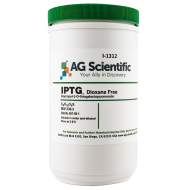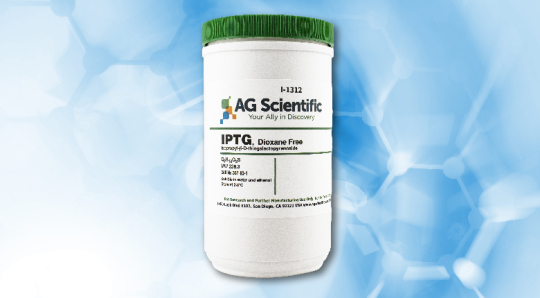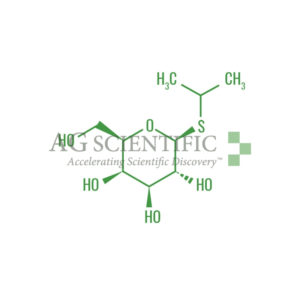IPTG (also known as Isopropyl-β-D-Thiogalactopyranoside) is a molecular biology reagent utilized in cloning experiments. This compound is used as a molecular mimic of allolactose, a lactose metabolite that triggers transcription of the lacoperon. Unlike allolactose, the IPTG sulfur (S) atom creates a chemical bond which is non-hydrolyzable by the cell, preventing the cell from "eating up" or degrading the inductant; therefore the IPTG concentration remains constant.
IPTG functions as an inducer of galactosidase activity by binding to and inhibiting the repressor. It is utilized for the induction of expression from the lac promoter and derivatives. IPTG is also used to differentiate recombinants from non-recombinants in cloning strategies using vectors containing the Z or Z peptide gene.
Frequently Asked Questions
What are the alternative names for IPTG?
- Isopropyl-β-D-thiogalactopyranoside
- Isopropyl β-D-1-thiogalactopyranoside
- Isopropyl-β-D-thiogalactoside
- Isopropyl β-thiogalactoside
- (2R,3R,4S,5R,6S)-2-(hydroxymethyl)-6-propan-2-ylsulfanyloxane-3,4,5-triol
- CAS 367-93-1
What is an operon?
An operon is a functioning unit of genomic DNA that has cluster of genes. They are under the control of a single regulatory signal or promoter.
What is the lac operon?
The lac operon is an operon required for the transport and metabolism of lactose in Escherichia coli and some other bacteria. It has lacZ, lacY and lacA, which are three adjacent structural genes. It is regulated by several factors and the availability of glucose and of lactose.What are the requirements for stock solutions of IPTG?
We recommend a a 0.1 M solution. The formula weight is 238.3 g/mol, so this is 0.238 g in 10 ml of water. Sterilize by filtration, then store in the freezer.What is the MERCK index number?
Merck Index for IPTG: (14) 6425.How do you spread IPTG on plated media?
- Spread the chemicals on top of the plates before you use them. Putting IPTG and X-GAL on top of pre-made agar plates. Spread 40 µL of IPTG and 40 µL of X-GAL on top of the plate with a hockey stick spreader. Then, let the plates dry before you use them. This should take 30 minutes or so if the plate is dry (e. a day or two old), but up to several hours for freshly made plates.
- Pour the plates with IPTG and X-GAL in them, incorporating IPTG and X-GAL into the plates before pouring. After autoclaving the media and cooling it to 65oC or less, add IPTG to a final concentration of 0.1 mM IPTG ( 1 µL IPTG stock solution per ml of media) and X-GAL to a final concentration of 40 µg/mL (2 µL of X-GAL stock solution per ml of media). Also be sure to add the selection drug at this time: usually ampicillin to a final concentration of 100 µg/mL.
- Incorporate the chemicals into top agar. This method is generally used for bacteriophage, but also works for bacterial colonies. Use 3 mL of 0.7% agar (or agarose if you want DNA that can be cut with restriction enzymes) kept at 50ºC. Add 10 µL IPTG stock and 40 µl of X-GAL stock. Then add the bacteria and phage mixture, mix quickly by rolling the tube between your palms, and pour it onto the plate.
At what concentration is IPTG induction typically carried out?
IPTG concentration for induction is around 0.5-1 mM.
How do I make IPTG 0.1 M concentration solution in 50 mL?
- Dissolve 0.595 g IPTG (MW = 238.3 g/mol) in water.
- Adjust final volume to 25 mL with sterile water.
- Make 1 mL or 5 mL aliquots and sterilize by 0.22 µm filtration and store at 20°C.
How do I make a 100 mM concentration solution in 1 mL?
Dissolve 23.8 mg in 1 mL of sterile water and store at 20°C.
How do you prepare Luria Broth/Ampicillin/IPTG/X-gal plates?
- First prepare a Luria broth-ampicillin plate and store the plate in 4°C fridge for three days.
- Take Luria broth-ampicillin plates into laminar flow, spread 100 µL IPTG on plates and let adsorb by placing inverted in 37°C incubator for 30 min.
- Spread 20 µL of X-Gal onto plates, then let adsorb again at 37°C.
What do I do if I forgot to add X-Gal/IPTG to my media?
If transformants are already on the plate and have grown visible colonies, do not swirl around the X-gal/IPTG solution because it will smear your colonies. A proposed solution is to replicate your colonies:- You could pick your colonies and streak them onto a plate containing the X-gal/IPTG/antibiotics desired.
- Alternatively, you could plate-replicate your colonies (provided that the colony density is low and individual colonies are well-spaced). You can replicate the colonies on 3M Whatman paper by pressing the plate onto it. Remove the old plate then press onto your new X-GAL/IPTG/antibiotic plate.
What is the protocol for the extraction of protein from bacteria?
Fast Induction (does not work for all, can give suboptimal yields):
- From a relatively fresh plate (<4 weeks), pick a colony and grow O/N at 30°C (or 37°C) in 1-2 mL LB+AMP (or other selection) in a 15 mL snap cap tube on a rotator or shaker.
- Dilute 1:50 (1:100 if 37°C O/N) in 2 mL LB+AMP and grow 3-4 hours at 37°C in 15 mL snap cap tube in a rotator.
- Prepare 1 mL LB+AMP+1mM IPTG in a 15 mL conical and prewarm to 37°C about 10 min before use.
- After 3-4 hrs remove 1 mL from tubes at 37°C and place in labeled 1.5 mL tubes. Spin at max, 30 sec, room temperature, and remove super. Freeze pellet at -20°C until needed. THIS IS THE UNINDUCED CONTROL.
- Add pre-warmed 1 mL LB+AMP+1 mM IPTG to 15 mL snap cap tube and return to 37°C for 3-4 hours. This will get the final volume back to 2 mL and the final concentration of IPTG to 0.5 mM.
- After 3-4 hrs transfer 1 mL from induced sample to labeled 1.5 mL tubes and spin at max, 30sec, room temperature, and remove super. Freeze pellet at -20°C until needed. THIS IS THE INDUCED SAMPLE.
- Sample preparation for SDS-PAGE: Add 100 uL of 1X loading buffer (see solutions below) with 1% BME to uninduced and induced samples. Vortex for 10 sec to 1 min or until there are no clumps of bacteria. Boil 3-5 min, spin at max, 30 seconds.
Slow Induction (can enhance solubility of proteins):
- Add 20°C 1 mL LB+AMP+1mM IPTG to 15 mL snap cap tube and incubate rotating or shaking at 20°C for 12-16 hours. This will get the final volume back to 2 mL and the final concentration of IPTG to 0.5 mM.
- After 12-16 hours, transfer 1 mL from induced sample to labeled 1.5 mL tubes and spin at max, 30 sec, room temperature, and remove super. Freeze pellet at -20°C until needed. THIS IS THE INDUCED SAMPLE.
- Note: If you boil your sample too long, it will become viscous from total release of cellular DNA. You can still use the sample if you can find an area of low viscosity; however, it’s usually better just to repeat the experiment.
Extraction of Soluble Proteins:
- Wash the bacterial pellet with 2 mL of ice cold STE (10mM TRIS, pH 8.0; 150 mM NaCl; 1mM EDTA) one time.
- Resuspend the bacterial pellet (from a 10 mL induced culture) in 800 µl of STE containing 100 µg/mL of Lysozyme (added immediately prior to resuspension).
- Incubate on ice for 15 minutes.
- Add DTT to a final concentration of 5 mM.
- Add protease inhibitors.


